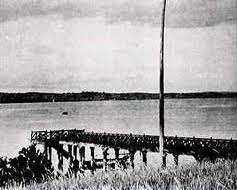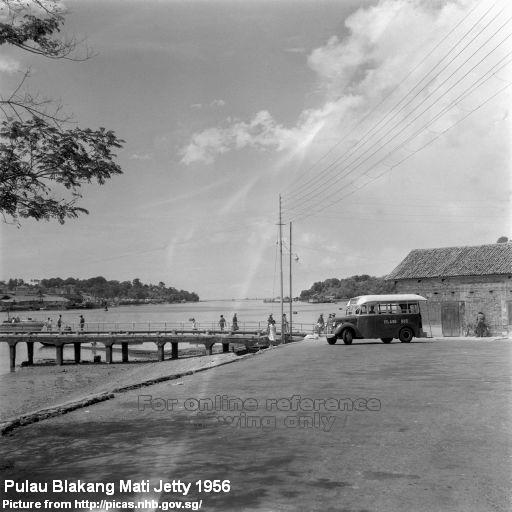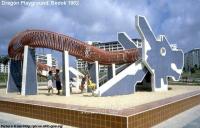As an island surrounded by waters, Singapore used to have numerous old jetties and piers located around it, which were once used for boat trips to Malaya or between the islands.
So what are the differences between a jetty, a pier, a quay and a wharf? According to Oxford dictionary, a jetty is defined as a landing stage at which boats can be docked, or a breakwater to protect or defend a harbour, coastline or riverbank. A pier is a larger version of a jetty.
Quays and wharves are platforms projecting into the water for loading and unloading ships. In Singapore, there are the Boat Quay, Clarke Quay, Collyer Quay and Robertson Quay, while the harbours and dockyards at Tanjong Pagar, Pasir Panjang and Sembawang are named as wharves.
The Jetties
In the early 20th century, seaside houses and jetties were commonly found along the coastlines of Tanjong Katong. Built either for leisure or fishing purposes, many of these outhouses were destroyed during the Second World War, while the remaining ones had to make way for the land reclamation in the seventies.
Punggol Jetty (1930s-Present)
Punggol Jetty and Punggol Point were well-known in the eighties and nineties for their seafood restaurants which served delicious crabs, cooked in chilli or tung-hoon styles, and mee goreng. A walk along the coast or on the jetty after a sumptuous dinner was a treat for many. In the past, there were also boatels providing services and equipments for activities such as boating, water-skiing and diving.
The history of Punggol Jetty goes back to the 1930s, when it was built for the Malay fishermen, as well as the trading and wholesaling activities by the Chinese settlers. It might also be used for the loading and unloading of goods for the early Punggol Zoos. A bad memory of Punggol Point was the massacre of 400 Chinese civilians by the invading Japanese forces at the nearby beach in 1942.
In 2011, Punggol Point, along with the jetty, was developed as part of the Punggol Promenade project. The new Punggol Jetty Park, furbished with board walks and cycling tracks, serves as the gateway to the other parts of the waterfront.
Lim Chu Kang Jetty (undetermined-Present)
Popular among photography enthusiasts, Lim Chu Kang Jetty represents a rural and remote side of Singapore that has been largely undisturbed in the north-western part of the island. Located at the end of the long quiet Lim Chu Kang Road, the jetty is made up of wooden planks and pillars that stretched 100m into the waters.
On any clear sunny days, there are busy loading and unloading of fish and other seafood via this jetty, while the police coast guards stationed beside the jetty keep a close eye on any illegal immigrants or trespassers.
The whole stretch of coastline from Gelang Patah to Sri Gelam of Johor Bahru can be captured in a panoramic view, while one can also notice the dozens of kelongs that line up along Johor Straits. The Lim Chu Kang Pier-House (mentioned below) is also easily visible from the jetty.
Plastic containers, tied together in rows, are used to support its platform. On stormy days, the flimsy jetty tends to sway in the strong waves and winds.
Sembawang (or Mata) Jetty (1940s-Present)
The Sembawang Jetty began in the 1940s as a simple wooden jetty. It was probably first used by the British, who had their Commander-In-Chief of the China Station for Britain, Admiral Geoffrey Layton (1884-1964), staying at Beaulieu House. The grand seaside bungalow, built in 1910 by a plantation owner, stands on a slope overlooking the jetty.
The jetty was also known as Mata Jetty, named after the nearby Mata Road. Before the nineties, there was a network of roads, namely Mata Road, Beaulieu Road and Kelopak Road, that led to the jetty. They were later demolished to make way for the full development of Sembawang Park.
The stone walkway leading to the jetty was never completed by the British; its construction was disrupted by the Second World War. It was actually completed by the Japanese, who had captured and occupied the nearby Sembawang Naval Base. Another pier at Sembawang, named Seletar Pier, was heavily damaged during the Japanese invasion (mentioned below).
Located at the end of Sembawang Road, the isolated jetty was also formerly a venue for fishing and crabbing by the villagers from the now-defunct Kampong Wak Hassan. In 1975, Sembawang Jetty caught the attention of the media when a man named Lim Back Yong plunged his borrowed car off the jetty in an attempted suicide. His wife Neo Yoke Kua drowned, while Lim Back Yong escaped and survived the ordeal. He was later imprisoned for 10 years for culpable homicide.
The jetty is currently a popular spot for fishing enthusiasts.
Labrador Jetty (1962-2010)
For more than 30 years, between 1962 and 1997, the Labrador Jetty, or Labrador Park Jetty, was originally used to ship liquid petroleum to and fro an oil refinery at Tanjong Berlayer.
The 12-hectare and S$25-million petroleum refinery was first established and operated by Maruzen & Toyo Oil Refinery. It was officially opened by then-Minister for Finance, Goh Keng Swee on 21 March 1962. Two years later, its operations were taken over by the British Petroleum (BP) Refinery Singapore Private Limited, which distributed finished products to other Asian countries.
When the refinery ceased operation in 1997, the site and jetty were returned to the Singapore government. With public funds and some sponsorship from BP Amoco, the jetty was refurbished and opened to the public in 1999. Labrador Jetty became popular with fishing and photography enthusiasts.
The gate to the jetty was closed by the park ranger every night to discourage night fishing, but in 2010, the National Parks closed the entrance to the jetty and its rocky shore permanently, citing public safety.
Bedok Jetty (1966-Present)
Measured a total of 250m, Bedok Jetty was formerly Singapore’s longest public jetty before the opening of the new Woodlands Waterfront Jetty. Despite its name, it is located at the popular East Coast Park.
The jetty started in 1966 as a private jetty for local businessman Yap Swee Hong, who built it at a cost of S$1.5 million. The Vietnam War (1955-1975) had been ongoing for a decade, prompting Yap to invest in the lucrative business of importing scrap metal from the Americans.
Bedok Jetty was later taken over by the Ministry of Defence (Mindef) as a military base for conducting regular military exercises as well as international humanitarian missions, including the Operation Thunderstorm of 1975.
The concrete jetty was later opened to the public, although it has maintained its status of a Mindef military base till today. Since then, it has been a popular venue for anglers, joggers, cyclists and couples taking strolls after a sumptuous dinner at the nearby East Coast Lagoon Food Village.
Former Royal Malaysian Navy (RMN) Jetty (1966-1981, 2010-Present)
In the guerrilla battle against the communists during the Malayan Emergency (1948-1960), the Malayan Naval Force was reactivated by the British and based in Woodlands of Singapore. The navy was bestowed with the title of “Royal Malayan Navy” by Queen Elizabeth II in 1952. Following Malaysia’s independence in 1958, the navy was transferred to the newly-formed Federation, and was renamed as Royal Malaysian Navy five years later.
Located within the restricted compounds of the former naval base, the RMN Jetty was opened in 1966. It was 400m long, including an outer arm of 735 feet (approximately 224m) in length. Also known as Malaysian Base Jetty, it was used regularly by the RMN, including events such as commissioning of new ships. Following the shifting of RMN to Johor in 1981, the naval base and its jetty was left vacated until 1997, when the Malaysian government agreed to transfer the properties to Singapore.
Since then, the site of the former naval base was redeveloped but the L-shaped jetty remained restricted and out of bound to the public. It was not until 2008 when the Urban Redevelopment of Singapore (URA) unveiled the proposal of the Woodlands Waterfront, a coastal promenade and park in the northern part of Singapore.
The jetty is refurbished with concrete pathway, replacing the old wooden planks, and has rows of new street lamps installed. A Halal seafood restaurant is also set up in the middle of the jetty.
Another restricted jetty, the Shell-owned T-shaped 175m-long Woodlands Jetty, is located about 250m beside the former RMN Jetty.
The longest restricted jetty, at more than 1km long, is located in the Changi Naval Base, where it stretches into the southeastern part of Singapore.
Commando Jetty and Others
Many male Singaporeans would not be unfamiliar with the Commando Jetty located at one end of Hendon Camp. That was formerly the venue where countless of recruits boarded the RPL (ramp-powered lighter) on their trips to Pulau Tekong, which marked the start of a strenuous eight-week BMT (Basic Military Training).
That dreaded feelings of having to book-in on Sunday evenings were demonstrated on almost every NS personnel’s face, as they waited patiently at Commando Jetty. The slow RPL seemed to take forever to reach the Ladang Jetty of Pulau Tekong. The reversal occurred on Friday evenings, when the NS personnel made their trips back to the main island of Singapore in high morale.
Most of the outlying islands of Singapore have jetties of their own. Before the eighties, kampongs had largely existed on these islands, and the main transport for the villagers between the Singapore mainland and the islands was by boats.
The Pulau Ubin Jetty had a grand opening in 1965, a couple of months after Singapore achieved independence. Built for the convenience to the islanders, the wooden jetty was later replaced by a concrete version.
Before the pedestrian bridge and the vehicular causeway to Sentosa were built in 1978 and 1992 respectively, the trips to the island, known as Pulau Blakang Mati before 1972, were by boats via a wooden jetty.
The Piers
Dalhousie Pier (1850-1900s)
Dalhousie Pier was named after the visit of Singapore by the Marquis of Dalhousie, Lord James Andrew, in 1850. The Marquis, who was also the Governor-General of India between 1848 and 1856, was welcomed by the locals who anticipated an improvement in the government’s administration of the colony.
Located near the mouth of the Singapore River, the area around Dalhousie Pier was also named as Dalhousie Ghaut. The Dalhousie Obelisk, donated by the prosperous merchant community, was also erected in the honour of the Marquis. However, their hopes of improved public works, amenities and the settlement’s administration did not materialise in the end.
Johnston’s Pier (1856-1933)
One of the earliest piers in Singapore, Johnston’s Pier was built by the Municipal Commissioners in 1856 to assist in the shipping development along the shoreline at the southern part of the Singapore River.
Upon completion, the pier was named Johnston’s after Alexander Laurie Johnston (undetermined-1850), a Scottish merchant and shipowner who arrived at Singapore in 1820. During his 22-year stay in Singapore, Johnston was appointed as Singapore’s first Magistrate and Justice of Peace, and helped extensively in establishing the Singapore Chamber of Commerce. Before he left Singapore in 1841, the well-respected Johnston was honoured in his farewell gatherings by the Chinese and Arab merchants.
The pier, constructed with iron and wood, had welcomed countless of important guests and delegates who landed at Collyer Quay, including Prince Alfred Ernest Albert (the Duke of Edinburgh), King Chulalongkorn of Siam, Prince Albert Victor and Prince George of Wales, King David Kelakaua of Hawaiian Islands and Prince Henry of Prussia.
Johnston’s Pier was torn down in the early 1930s, with its role replaced by the newly-constructed Clifford Pier.
Clifford Pier (1933-2006)
Perhaps better known by its localised name Red Lamp Pier 红灯码头 or lampu merah (A red oil lamp was used to guide the ships that entered the harbour. Johnston’s Pier was also formerly known as Red Lamp Pier), Clifford Pier was constructed in 1933 to take over the role of Johnston’s Pier. Designed by the Public Works Department (PWD), it was named after Sir Hugh Charles Clifford (1866-1941), the Governor of the Straits Settlements between 1927 and 1929.
A little trivia about Clifford Pier happened on its opening day in June 1933, when the event was boycotted by the merchants who wanted the new pier to be named after Alexander Laurie Johnston too.
In its 70-plus years of operation, Clifford Pier had witnessed tremendous changes of the busy Collyer Quay. It continued to be one of the landing points for oversea guests and delegates, as well as foreign immigrants and workers. In 1942, Japanese warships waited in the open seas to sink the ships that left Clifford Pier carrying the refugees.
In the sixties, the pier’s carpark spiced up the night life of downtown Singapore as it was converted into a popular makan place, served by the street hawkers when night fell, similar to that of the famous Orchard Road Carpark Hawker Centre. Things would change in the seventies, as the Red Lamp Pier gradually became a red-light district roamed by prostitutes.
In 2006, Clifford Pier ceased its operations and replaced by the new double-storey Marina South Pier. The pier, along with the former Customs Harbour Branch building (built in late 1960s) and Change Alley Aerial Plaza (built in 1971), was conserved by the Urban Redevelopment Authority (URA) in 2007.
Lim Chu Kang Pier-House (1930s-Present)
The Lim Chu Kang Pier-House, or simply “The Pier”, was formerly a splendid weekend chalet owned by the famous Irish Cashin family, who also possessed other properties in Singapore such as the Matilda House (Punggol) and the “Butterfly House” (Amber Road).
It was rumoured that in the 1930s, the Sultan of Johor often visited Singapore via “The Pier”. When the Japanese forces invaded Singapore in 1942, “The Pier” was captured and used as a leisure resort for the senior Japanese officers. After the war, the Cashin family re-claimed their property, and had been using the house, well-equipped with electricity, modern toilets and barbeque pits, until 2009.
“The Pier” is currently under the charge of the Singapore Land Authority (SLA).
Seletar Pier (1920s-1970s)
Built in the 1920s, the Seletar Pier provided accessibility for the British military to travel via the waters during their surveying of the lands around present-day Sembawang. The surveying was carried out for the planning of Sembawang Naval Base, which began its construction in 1928 and completed only a decade later. The naval base, dubbed by then Britain’s Prime Minister Winston Churchill as the “Gibraltar of the East”, was to act as a deterrent to an increasingly ambitious Japanese Empire.
The pier was given the name of Seletar as it was standing at the end of a muddy track known as Seletar Road. The road was later developed and renamed as Sembawang Road.
In February 1942, the Japanese deceived the British into an impression that their invading forces were landing at Changi, where in fact, the enemies would be coming from the north-western part of Singapore. From Johor Bahru, the Japanese pounded the areas around Mandai, Sembawang Airbase and Tengah Airbase with heavy artillery. One of the raids inflicted considerable damages on the Seletar Pier.
The pier was never given full repair after the war. By the 1960s, it had become derelict and abandoned. Today, remains of the pier can still be found at Sembawang Park.
Published: 01 October 2012
Updated: 25 October 2012
Discover more from Remember Singapore
Subscribe to get the latest posts sent to your email.
































Nice write-up! Thanks for your effort. But just asking, is the Lim Chu Kang jetty still open to the public? Is it the one near a dead-end? I remember going there in the past, but in recent years, it has been cordoned off? Hmmm.
Yes, the LCK jetty is located at the end of LCK Road.
I was there a few weeks back… It’s opened to the public although it’s a “private” jetty
This is an absolutely brilliant post.
A 1992 photo of Punggol Jetty (with old railings), with the famous Punggol seafood restaurants at the background
Wonderful write up. I have visited almost all of the existing jetties. But the one at the end of Lim Chu Kang rd is the most exciting as it is an adventure back in time.
Is it possible to provide more info on Singapore double jetty at east coast park?
Or better known as six pipes jetty? The history behind the construction of the jetty?
Will appreciate it.
Many thanks…
Best regards.
I used to go to this quiet little jetty on the west side of Singapore but I don’t know where it is anymore.
Outside the jetty was this NTUC warehouse which I can no longer find as well.
I remember very well in the late 1940’s when my dad took us fishing at night by the fence on Clifford Pier. We caught big Ikan Cerrimin or African Pampano, groupers, red snappers. The rocks and water was deep and clean then.
I caught my first big fish at the Post Office pier next to Clifford Pier then and I am hooked till this day. It almost pulled me in, it was a big cat fish.
I miss Singapore and someday may return and go fishing at the Bedok Pier. These days I fish at my dock at the back of my house and catch Snook (Siacap) red fish or snappers. We live in on a canal that takes us out to the Gulf Of Mexico in Florida USA.
Yasmin Workman
Woodlands jetty got halal seafood restaurant?
Johnston’s Pier welcomed Nicholas Tsar II sometime 19th to 21st February 1891-(4pm) Later on in years, Nicholas was crowned the the Russian Tsar (Last one in History).Nicholas and his family were eventually murdered by their Bolshevik guards on the night of 16/17 July 1918.
This is really a good website to tell vivid stories about Singapore, highly appreciate your efforts and sharing.
Will you share stories for the jetty on St John’s and Pulau Hantu?
Thank you.
Stay safe.
The good old Lim Chu Kang Jetty has been demolished….